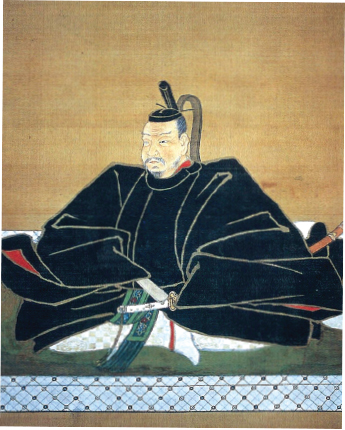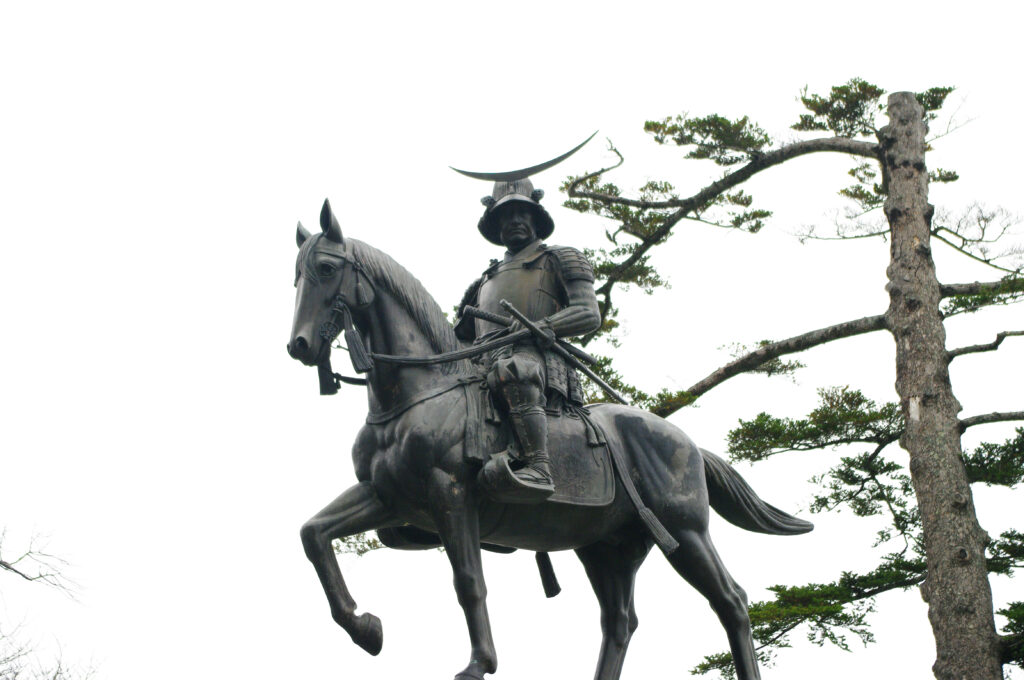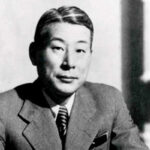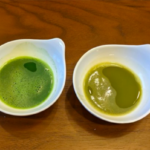

伊達政宗 DATE Masamune
1566 – 1636
Name List of Masamune
(Japanese historical figures change their names frequently.)
Bontenmaru → Date Tojiro Masamune
Masamune The On-eyed Dragon
The popular warlord from Azuchi-Momoyama (last part of the Sengoku period) through early Edo period, Date Masamune was made all the more iconic for his missing eye, called “One-Eyed Dragon (独眼竜, Dokuganryu)”. Masamune has significantly influenced the History of Japan, and particularly the Tohoku region, as the 17th head of the Date clan. He was an outstanding tactician, and a founder of the modern-day city of Sendai. Well-known for his eye-patch and fearsome crescent moon kabuto (helmet) which may have inspire George Lucas to create the famous helmet of Darth Vader, the main antagonist of the first Star Wars trilogy, and the Dokuganryu has been a mainstay in Japanese pop culture. What made Masamune especially famous was the Taiga Drama (histrical period drama) broadcasted by NHK, that Ken Watanabe, who is a worldwide famous actor today, played the role of Date Masamune in. The drama telling the life of Masamune became a huge hit in entire Japan. Masamune is also one of the main characters in the well-known and much loved anime and videogame series, Sengoku Basara.
Early Life
Date Masamune was born as Bontenmaru (梵天丸), the eldest son of Date Terumune who was a lord of the Rikuzen province of Mutsu, in September 1566 in Yonezawa Castle (in Yamagata Prefecture today). His mother was Yoshihime, a daughter of Mogami Yoshimori who was a daimyo (powerful Japanese feudal lords) of the Dewa province. It is said that Masamune’s father Terumune named his son as Masamune, after the 9th lord of Date clan Masamune who was the founder of a revival of Date clan. In 1571, Masamune lost his eyesight of the right eye due to smallpox, and he was called “Dokuganryu” later due to this happening. His father Terumune was concerned about the future of him, so he invited a Zen priest of the Rinzai sect, Kosai Souitsu, for Masamune to teach Buddhism and Sinology with strict instruction. Masamune celebrated his coming of age in 1577, he was 11 years old. At that time, it was very common that boys celebrate their coming of age at 15, so it was unusual Masamune did it at 11. He received then the name Tojirou Masamune (藤次郎政宗) in 1578, and the following year, he got married to Megohime who was a daughter of Tamura Kiyoaki, a lord of Miharu castle in Mutsu province. In 1581, when he was 17 years old, he led his campaign for the first time to help Terumune at the battle against Soma family. Three years later, Masamune succeeded Terumune who retired from daimyo position in 1584, and became the 17th head of Date clan. At that time, Terumune was 41 years old and still fit to work. So at first, Masamune was refused to be the header because he was still too young for that. However, Terumune was so determined as he saw through the talent of Masamune as a military commander, and Masamune finally accepted the succession of family headship.
Career and Footage
Even he experienced several defeats as a young head of the clan in his early career, Masamune gained his footing as a leader and soon became one of the most feared warlords in the country. When he branched out, he decided to go on the offensive to conquer the neighboring clans. In 1585, one of the neighbor clans Hatakeyama Yoshitsugu chose to surrender to the Date clan. Masamune accepted the surrender, but proposed a condition to give up most of their territory to the Date clan. So Yoshitsugu kidnapped Terumune. When this incident occurred, Masamune was out in the field for hunting, but he rushed back to the castle and chased after the entourage of Hatakeyama, and shot everyone to death along with his father. This incident spread the name of Date Masamune in the entire Oushu region. In 1589, Masamune defeated Ashina Yoshihiro at the Suriagehara war, and became almost invincible in Oushu with more than 1.1 million goku (278,000 cubic meters). At the time of succession to the family, Date clan was about 300,000 goku.
In the following year, Toyotomi Hideyoshi seized Hojo’s Odawara Castle, and required Masamune to participate. Masamune first refused, but did it belated, the delay infuriated Hideyoshi. However, Hideyoshi still spared Masamune’s life, and Masamune had to relinquish his newly won holdings in Aizu and was given Iwatesawa and the surrounding lands. Masamune moved there in 1591, rebuilt the castle and renamed it Iwadeyama, encouraged the growth of a town at its base, and stayed there for 13 years and turned the region into a major political and economic centre. Masamune then allied with Tokugawa Ieyasu against Hideyoshi, and aided him in seizing power following Hideyoshi’s death, held a successful reign over his territory under the supervision of shogun Tokugawa. After the Battle of Sekigahara, Ieyasu permitted Masamune to relocate and build a new castle in Aobayama, in today’s city of Sendai (in the region ravaged by the 2011 earthquake and tsunami). Masamune moved then to Sendai as his home base and built Sendai Castle (Aoba castle) which holds the title as the country’s biggest castle, and measures 245 meter (approx. 804 ft.) from the east and west and 267 meter (approx. 876 ft.) from the north and south. The castle towns in 1601, and Masamune became the first lord of Aoba castle. The grid plans for the roads of today’s Sendai are still based on his original plans. He turned this city from a small rural community into a prosperous city.
Masamune was known for openness to foreigners and to Christian missionaries in his province, kept several Christians under his protection, encouraged to travel foreign countries, and sent a letter to the Pope in Rome to try to establish an alliance, and ordered an exploration ship, the Date Maru or San Juan Bautista which became a part of the first Japanese voyage to sail around the world. The replica of the Date Maru is still to find in Ishinomaki, Japan. One of the first shrines of Sendai city, Osaki Hachimangu (大崎八幡宮) was founded by Date Masamune in 1607.
Later in life, he found his mind at peace with cooking and enjoying Noh (Traditional Jap anese masked drama with dance and song) and lived quietly. In 1636, he became sick and so weak that he even couldn’t walk and eat, and died at the age of 69. He had 16 children. Masamune held the titles of Echizen no Kami and Mutsu no Kami. He was succeeded by his son Tadamune. Masamune’s mausoleum, Zuihoden (瑞鳳殿) temple is one of popular tourist spot today. His grave was opened in 1974, and his remains, his sword, a letterbox and his armor which is recognized by its black armor and golden headgear were discovered. The archaeologists determined him to have stood 159.4cm (approx. 5.23 ft.) tall, and having blood type B.

.
.
.




